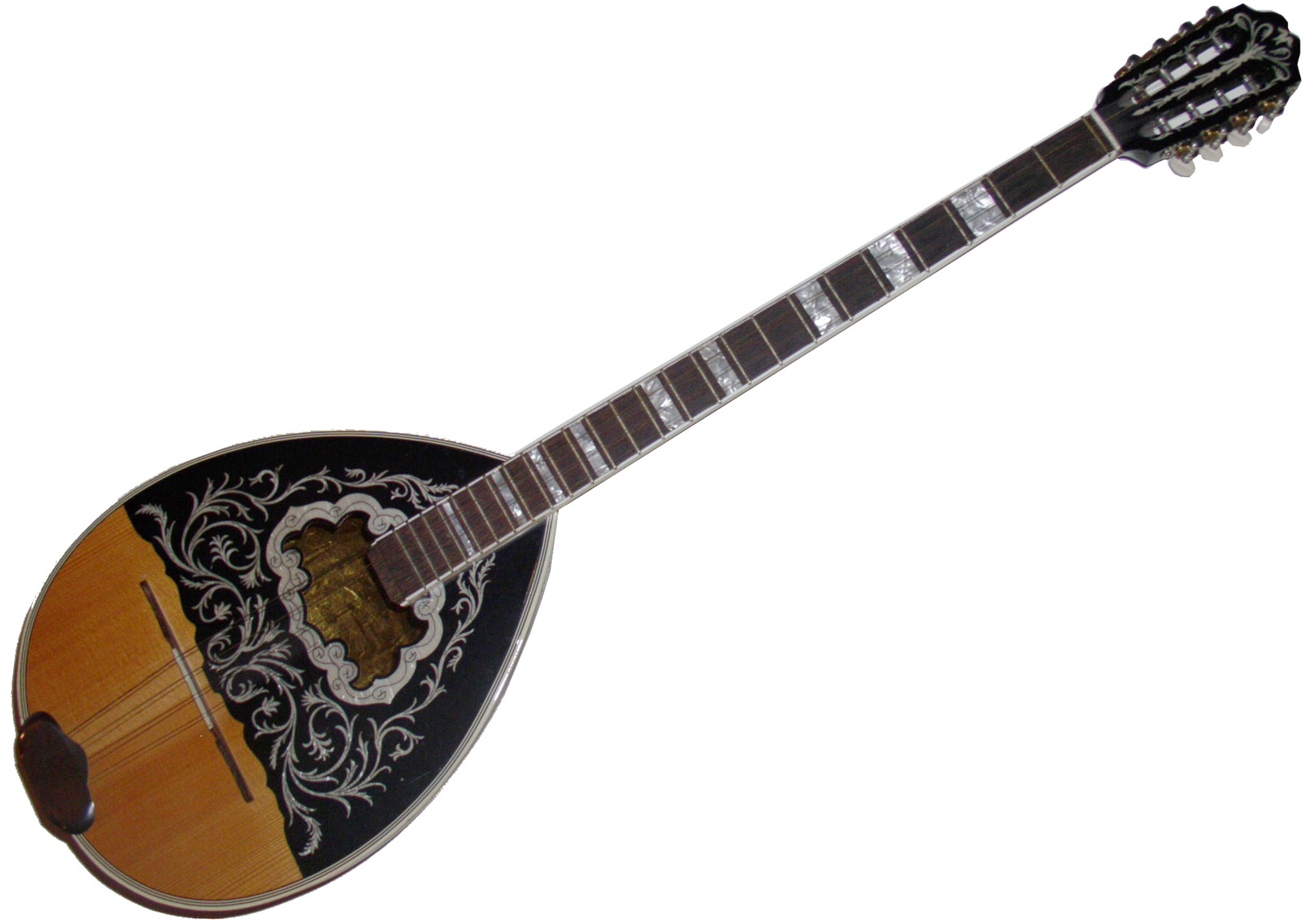- Bouzouki
Infobox Instrument
name=Bouzouki
names=
classification=
*Plucked string instrument
range=
related=
* Bağlama (Turkey)
*Cittern
*Tar (lute) The bouzouki (gr. το μπουζούκι; pl. τα μπουζούκια) (plural sometimes transliterated as "bouzoukia") is the mainstay of modern
Greek music . It is a stringed instrument with a pear-shaped body and a very long neck. The bouzouki is a member of the 'long necklute ' family and is similar to amandolin . The front of the body is flat and is usually heavily inlaid withmother-of-pearl . The instrument is played with aplectrum and has a sharp metallic sound.Many musicians such as
Manolis Chiotis andGiorgos Zampetas began using specially designed pickups to achieve a slightly thickerhumbucker -like sound in the mid-1960s. These pickups are widely used by several Greek artists today and came in active and (usually) passive versions. Bouzouki pickup manufacturers include EMG, Lace Actodyne andSeymour Duncan .There are two main types of bouzouki:
* "Three-course," having three pairs of strings (courses).
* "Four-course," having four pairs of strings.History
In
Greece , this instrument was known as thepandura or pandourion, also called the "trichordo" because it had three strings; it was the first fretted instrument known, forerunner of the various families of lutes worldwide. The source of our knowledge about this instrument is theMantineia marble (4th century BC, now exhibited at theNational Archaeological Museum of Athens ), depicting the mythical contest betweenApollo andMarsyas , where a pandouris is being played by a muse seated on a rock.From Byzantine times it was called the tambouras. The modern Turkish
Tanbur is practically identical to the ancient Greek pandouris. On display in the National Historical Museum of Greece is the tambouras of a hero of the Greek revolution of 1821, GeneralMakriyiannis . This tambouras bears the main morphological characteristics of the bouzouki used by theRebetes .The Turkish
Saz belongs to the same family of instruments as the bouzouki. A middle-sized kind of saz is called a "bozouk saz". Bozouk in Turkish means "broken, not functioning, modified". Here it is used in order to specify the size of the instrument. It is concluded, therefore, that the bouzouki has been named after the jargon of the Turkish saz. An alternative popular etymology maintains that the word "Bozouk" was used because different tunings (the Turkish 'düzen') are required for the instrument to play in different musical scales (known as Dromoi in Greek, Maqam (pl. Maqamat) in Arabic). A tuning known as the "bozouk düzeni" (broken tuning) still exists in Greek folk music.The early bouzoukia were mostly Three-string ("Trichordo"), with three courses (six strings in three pairs) and were tuned in different ways, as to the scale one wanted to play.
After the late '50s, four-course ("Tetrachordo") bouzoukia started to appear. The four-course Bouzouki was made popular by
Manolis Chiotis . Chiotis also used a tuning akin to standard guitar tuning, which made it easier for guitarists to play bouzouki, even as it angered purists.The
Irish bouzouki , with four courses, a flatter back, and differently tuned from the Greek bouzouki, is a more recent development, dating back to the 1960s.The three-course bouzouki (trichordo)
This is the classical type of bouzouki. It has fixed frets and it has 6 strings in three pairs, in modern times tuned Dd-aa-dd. This tuning was called the European tuning by
Markos Vamvakaris , who described several other tunings, or douzenia, in his autobiography. This is the type of bouzouki that was used forrebetiko . The illustrated bouzouki is a replica of a trichordo bouzouki used byMarkos Vamvakaris . It has tuners for eight strings, but has only six strings. The luthiers of the time often used sets of four tuners on trichordo instruments, as these were more easily available, since they were used on mandolins.The four-course bouzouki (tetrachordo)
This type of bouzouki has 8 metal strings which are arranged in 4 pairs, known as courses, typically tuned Cc Ff aa dd (i.e. one full note below the four high strings of a guitar). It was established in the scene by a major Rebetis, Manolis Chiotis, during the 1960s. In the two higher-pitched (
treble ) courses, the two strings of the pair are tuned to the same note. In the two lower-pitched (bass) courses, the pair consists of a thick wound string and a thin string tuned anoctave apart. These 'octave strings' add to the fullness of the sound and are used in chords and bass drones (continuous low notes that are played throughout the music).Notable players of the Greek bouzouki
*
Giorgos Zampetas
*Markos Vamvakaris
*Vassilis Tsitsanis
*Manolis Chiotis
*Ioannis Papaioannou
*Bebis Stergiou
*Kostas Papadopoulos
*Lakis Karnezis
*Yiannis Halikias
*Kostas Kaplanis
*Spyros Peristeris
*Karolos Milanos
*Yiovan Tsaous
*Giorgos Mitsakis
*Sporos
*Stelios Makrydakis
*Alan Doyle
*Keith Urban ee also
*
Music of Greece
*Rebetiko
*Irish bouzouki
*Stringed instrument tunings External links
* [http://www.bouzouki.com.gr/ Karolos Tsakirian - Greek bouzouki luthier in Athens]
* [http://www.bouzoukispot.com http://www.bouzoukispot.com - Bouzouki Spot - Greek Bouzouki Portal]
* [http://www.mpouzouki.com www.mpouzouki.com - Bouzouki Portal]
* [http://www.mpouzouki.com/kioulos/ Bouzouki Luthier from N.Y. Babis Kioulos]
* [http://www.bouzoukimaker.com/ www.bouzoukimaker.com Bouzouki Maker - George Stasinopoulos]
* [http://www.greek-bouzouki.com greek-bouzouki.com - Greek Bouzouki Manufacturer in Thessaloniki]
* [http://www.playbouzouki.com Playbouzouki.com - Learn How to Play the Bouzouki]
* [http://www.btinternet.com/~christopher.blackmore/rebetiko/roads.html Scales for trichordo bouzouki (dromoi)]
* [http://4stringchords.com/ Bouzouki Chord Finder]
* [http://www.floridamemory.com/Collections/folklife/sound_greek.cfm Recording of bouzouki music, made available for public use by the State Archives of Florida]References
Further reading
* cite book
title = The Greek Bouzouki Chord Bible: CFAD Standard Tuning 1,728 Chords
first = Tobe A.
last = Richards
location = United Kingdom
publisher = Cabot Books
year = 2007
id = ISBN 10: 0-9553944-8-1 ISBN 13: 978-0-9553944-8-5 —
Wikimedia Foundation. 2010.
